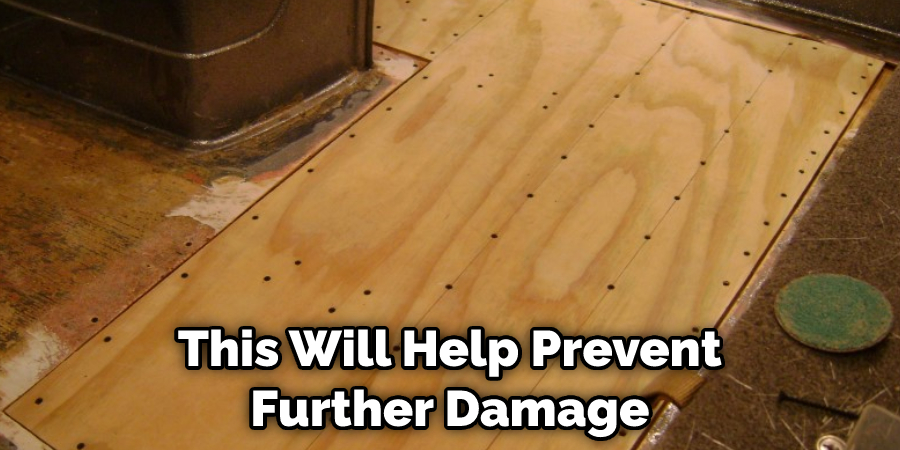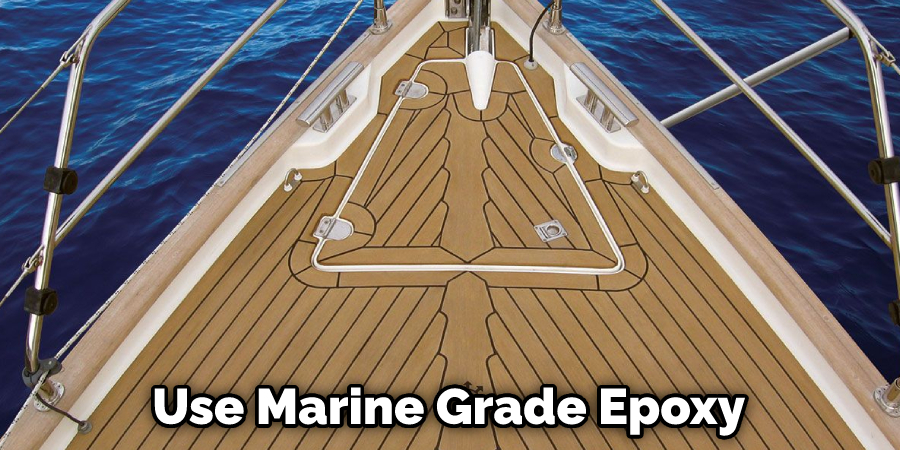If you’re like me, then you love spending time on the water. Whether it’s fishing, canoeing, or just cruising around, there’s nothing quite like it. But if your boat floor is rotted, then that fun time can quickly come to an end. So in this post, I’m going to show you how to fix rotted boat floor. Hopefully, this will help get you back out on the water sooner than later!
Summary: Fixing a rotted boat floor can be a daunting task, but with a little preparation and some simple tools, it’s definitely possible. First, make sure the floor is dry and free of any water or oil. Next, remove any loose boards or planks using a screwdriver or a wrench. Next, use a power drill to create holes in the floor at regular intervals. Finally, fill the holes with wood screws and nails, being sure to cover the screws with a layer of fatwood or marine plywood.

What Is a Rotted Boat Floor?
The sinking feeling of finding a rotted floor aboard your vessel is something that many boat owners have experienced. Whether it’s a small patch or an extensive area, rotted boat floors are a serious problem that needs to be addressed as soon as possible.
One of the most important structural elements of a boat is the floor. If it starts to rot, it can jeopardize the safety of the entire vessel. Rotted boat floors are usually caused by water damage, and they typically occur in areas with poor ventilation. If left unchecked, rotted floors can lead to major instability and even cause the boat to sink.
It’s important to repair rotted areas as soon as they’re discovered to prevent further water damage. There are a few different ways to do this, but the most effective method is to replace the affected panels with new ones. This will restore the strength and stability of the floor.
What Is the Cause of The Boat Floor Rotting?
1. Excess Moisture
One of the main reasons boat floors rot is excessive moisture. If your boat is stored in an area where it is constantly exposed to water or high humidity, this can lead to the formation of mold and mildew, which will eventually cause the floor to rot. In addition, if you do not properly maintain your boat and clean it regularly, this can also lead to the formation of mold and mildew.
2. Poor Ventilation
One of the most common causes of boat floor rot is poor ventilation. When moisture is allowed to build up on the floor, it will eventually start to rot. If you don’t have adequate ventilation in your boat, you’re likely to see problems with the floor over time.

3. Lack of Maintenance
If you do not properly maintain your boat, it will speed up the process of degradation and rot. Fiberglass boats should be washed with soap and water at least once a month, and you should also wax the hull. This will create a barrier against the sun and salt water, which can cause damage.
4. Poor Drainage
If your boat doesn’t have proper drainage, water will sit in the bilge and start to rot the floor from the inside out. Make sure your boat has adequate drainage by installing drain plugs and keeping them clear of debris. You should also check the hull for any cracks or holes to be repaired.
5. Exposure to Sunlight
UV rays can cause serious damage to your boat, especially true to the floor. If your boat is stored in direct sunlight, the UV rays will break down the fiberglass and cause it to become brittle. This can lead to cracks and eventual rot.
Why Should You Fix Rotted Boat Floor?
Any boat owner knows that a smooth sailing experience is maintaining a well-kept vessel. Unfortunately, boats can fall victim to wear and tear even with the best care, resulting in damaged or rotted flooring. While this may not seem like a big issue, it can lead to several problems, including leaks, mold, and structural damage.
Therefore, it is important to fix the rotted boat floor as soon as possible. This will help prevent further damage, but it will also restore the integrity of your boat. With a little time and effort, you can keep your boat looking and performing its best for years to come.

How to Fix Rotted Boat Floor Step by Step Guide
Step 1: Find the Problematic Areas
The first step is to identify the problem areas. Next, look for signs of water damage, such as discoloration, warping, or soft spots. Also, check for any holes or cracks that may be allowing water in.
Step 2: Remove the Rotted Sections
Once you’ve found the rotted sections of your boat floor, you’ll need to remove them. You can do this with a chisel and hammer or a rotary tool fitted with a metal cutting blade. Be careful not to damage the good sections of the floor as you remove the rotted sections.
Step 3: Prepare the Replacement Sections
Once you’ve removed all the rotted wood, it’s time to cut new pieces to replace it. When taking measurements, be sure to account for the thickness of the plywood and any other materials you’ll be using.
Use a sharp handsaw or power saw to cut the replacement sections from a new sheet of plywood. If your boat has a curved floor, you may need a jigsaw.
Step 4: Attach the Replacement Sections
Use marine-grade wood glue and screws to attach the new plywood sections to the existing floor. Be sure to predrill holes for the screws and countersink them, so they’re flush with the surface of the plywood.

Step 5: Reinforce the Joints
Once all the replacement sections are in place, it’s time to reinforce the joints. Use marine-grade epoxy to fill any gaps between the new and old plywood sections.
For extra strength, you can also install fiberglass tape over the joints. Allow the epoxy or tape to cure for the amount of time specified by the manufacturer before proceeding.
Step 6: Finish Up
Once the joints are reinforced, you can finish by sanding the floor and applying a new coat of paint or varnish. Again, be sure to use products specifically designed for use on boats.
There you have it! Our guide on how to fix rotted boat floor. With these steps, you’ll have your floor look new in no time.
How to Replace Boat Floor Step by Step Guide
Step 1: Take Everything Out of the Boat
The first step is to gut the boat. This means taking out everything that isn’t necessary for the vessel’s structure. This includes all the furniture, carpeting, and paneling. In addition, you want to remove anything that could be concealing damage or rot. Once you have emptied the boat, it’s time to start cleaning.
Step 2: Clean the Boat Thoroughly
It’s important to clean the boat before you start making any repairs. This will help you better understand the extent of the damage and where you need to focus your efforts. Start by scrubbing the entire interior with a strong cleaner. Pay special attention to any areas that look discolored or damp. Then, rinse it with fresh water once you’ve given the boat a good cleaning.

Step 3: Inspect the Boat for Damage
Now that the boat is clean, you can start an inspection for damage. First, look closely at the hull and decks for any rot or water damage signs. If you find any soft spots, use a screwdriver or chisel to test the integrity of the wood. If the wood is crumbly or soft, it needs to be replaced.
Step 4: Remove Damaged Wood
Once you’ve identified all the damaged wood, it’s time to remove it. First, use a chisel and hammer to remove rotted or softwood. Be sure to wear protective gloves and goggles while you work. Once you’ve removed all the damaged wood, use a sander to smooth out the area.
Step 5: Replace Damaged Wood
Now it’s time to replace the damaged wood. Cut new pieces of wood to fit the areas you’ve removed. Be sure to use marine-grade plywood or lumber treated for rot resistance. Use waterproof glue and screws to attach the new pieces of wood.
Step 6: Seal the Boat
Once you’ve replaced all the damaged wood, it’s time to seal the boat. This will help protect it from further water damage. Start by applying a primer to all the new wood. Then, use paint or varnish designed for marine use. Be sure to apply several coats for maximum protection.

Step 7: Enjoy Your Boat
After all your hard work, you can finally enjoy your boat. First, however, be sure to perform regular maintenance to help prevent further damage. If you keep up with the care of your boat, it will last for many years to come. Keep reading for more information about how to fix the rotted boat floor.
You Can Check It Out to Fix Corrosion on Aluminum Boat
Mistakes to Avoid When Repairing a Rotting Boat Floor
1. Not Cleaning First
When you first discover the rotten spot on your boat floor, it is tempting to start hacking away at the rot. But this will only spread the problem and make it worse. Instead, you need to remove all rotted material down to solid, fresh wood. This means scraping and sanding away everything soft and spongy. If you don’t, the rot will just come back.
2. Not Inspecting for Rot Elsewhere
Once you’ve identified and removed the rotten spot on your boat floor, you must inspect the rest of the floor for signs of rot. Water can seep into small cracks and crevices, causing damage that is not always immediately visible. Thoroughly inspect the entire floor and make sure to repair any other areas that show signs of water damage.
3. Not Using Marine-Grade Materials
When you are ready to repair the rotten spot on your boat floor, it is important to use materials designed for marine use. Regular wood fillers will not stand up to the elements and quickly rot away. You need to use marine-grade epoxy or polyurethane to create a lasting repair.

4. Leaving Rot Behind
One of the biggest mistakes you can make when repairing a rotten boat floor is to leave even a small amount of rot behind. Remember, water can seep into the smallest cracks and crevices, so removing all traces of rot is essential before proceeding with the repair.
5. Not Applying a Sealant
After repairing the rotten spot on your boat floor, you must apply a sealant. This will help protect the repair from further water damage and make it blend in with the rest of the floor.
6. Nailing the Boat Floor
Another big mistake people make when repairing their boat floor is to use nails. Nails will not hold the floor in place for long and will eventually work their way out, causing more damage. It is best to use screws when repairing your boat floor.
7. Not Finishing the Job
Once you’ve repaired the rotten spot on your boat floor, it is important to finish the job by replacing any removed flooring. This will help protect the repair further and restore the aesthetic of your boat.
8. Not Maintaining Your Boat
Of course, the best way to avoid having to repair your boat floor is to take good care of it in the first place. Regularly inspect your floor for signs of water damage and apply a sealant every few years. By taking good care of your boat, you can avoid future problems and keep it looking great for years to come.
If you have discovered a rotten spot on your boat floor, it is important to take action immediately. The longer you wait, the worse the problem will get. But don’t make the mistake of just hacking away at the rot. This will only spread the problem and make it worse.
Use this guide to avoid common mistakes and repair your boat floor correctly. If you want to know more about how to fix the rotted boat floor, keep reading.
You Can Check It Out to Fix Spider Cracks in Fiberglass Boat
Preventing Boat Floor Problems
While boat ownership offers a plethora of fun and excitement, it also comes with a unique set of maintenance challenges. One such challenge is preventing floor problems. Floor problems can cause serious damage to your boat and be costly to repair. Fortunately, there are a few simple steps you can take to prevent floor problems from occurring in the first place.
First, always keep your boat clean and free of debris. Second, make sure the floor is dry before storage or use. Third, inspect the floor regularly for signs of wear or damage. By following these simple steps, you can help keep your boat’s floor in top condition for years to come.

How Do You Know if Your Boat Has a Rotted Floor?
The best way to find out if your boat has a rotted floor is to inspect it regularly for signs of wear and tear. Look for cracks, holes, or soft spots in the flooring. These are all indicative of rot. If you find any of these signs, it’s important to act quickly to repair the damage before it worsens.
There are a few different ways to fix a rotted boat floor. The most common is to replace the affected boards. This can be done by removing the damaged boards and replacing them with new ones. Another option is to fill the holes or cracks with epoxy resin. This will provide a strong seal that will prevent further damage.
Frequently Asked Question
Can You Recommend Any Products that Would Help Me Fix My Rotted Boat Floor?
Yes, a few products can help you fix your rotted boat floor. First, you will need to remove the old and rotted flooring. Next, you will need to install new plywood or fiberglass sheets. Finally, you will need to seal the new flooring with a waterproof sealant.
Can Glue Injection Fix Rotten Core?
If you have a rotten boat floor, there is a good chance that the core is rotted away. This can happen due to water damage, age, or poor maintenance. Often, people think that they need to replace the entire floor when this happens, but this is not the case. You may be able to save your floor by using a glue injection.
What Is Material Used for Boat Flooring?
Boat floors are typically plywood, though some newer boats may have composite flooring. If your floor is made from plywood, you can fix it by replacing the damaged section with a new piece of plywood. If your floor is made from composite materials, you will need to replace the entire floor.
What Is the Best Wood for Boat Floor?
If your boat floor is rotting, you need to replace the floorboards as soon as possible. The best wood for boat flooring is hardwood, such as teak or mahogany. If you cannot find hardwood boards, you can use marine plywood.
Can Fiberglass Boats Rot?
Yes, fiberglass boats can rot, and it’s important to fix any damage as soon as possible. Unfortunately, the rotting process will only worsen over time, and it can eventually lead to the boat sinking.
Does Lowes Carry Marine Plywood?
You might be surprised to learn that Lowe’s does carry marine plywood. This type of plywood is specially treated to resist moisture and decay, making it an ideal choice for boat building or repair. For example, if your boat has a rotted floor, you can use marine plywood to replace it. It’s important to choose the right thickness of plywood for the job.
What Is Marine Plywood?
Marine plywood is a specially treated plywood designed to resist rotting in humid and wet conditions. It is usually made from tropical hardwoods, and the plywood is bonded with waterproof resins.
Conclusion
If you have a rotted boat floor, don’t despair! There are ways to fix it. With a little bit of work and some patience, you can have your boat looking good as new in no time. Follow these simple steps, and you’ll be on your way to enjoying boating season again in no time. Thanks for reading our post about how to fix rotted boat floor.
